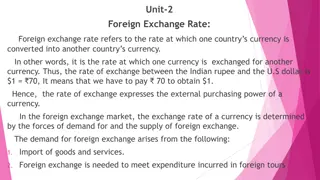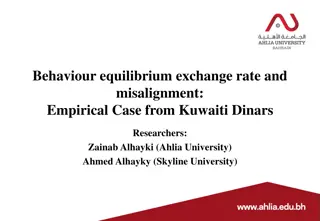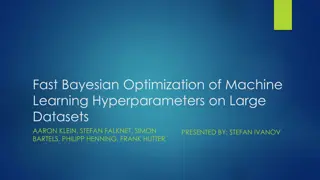Managing Interest Rate and Currency Risks: Strategies and Considerations
Interest rate and currency swaps are powerful tools for managing interest rate and foreign exchange risks. Firms face interest rate risk due to debt service obligations and holding interest-sensitive securities. Treasury management is key in balancing risk and return, with strategies based on expect
27 views • 21 slides
Improving Heat Rate Efficiency at Illinois Coal-Fired Power Plants
Heat rate improvements at coal-fired power plants in Illinois are crucial for enhancing energy conversion efficiency, reducing carbon intensity, and minimizing pollution. By increasing the heat rate/efficiency by 6%, these plants can generate more electricity while burning the same amount of coal. T
5 views • 11 slides
Wage Remuneration Methods Overview
Dr. B. N. Shinde, Assistant Professor at Deogiri College, Aurangabad, presents an insightful overview of methods of wage remuneration including Time Rate System, Piece Rate System, and Combination of Time and Piece Rate System. Time Rate System is the oldest method where workers are paid based on ti
4 views • 16 slides
Swarm Intelligence: Concepts and Applications
Swarm Intelligence (SI) is an artificial intelligence technique inspired by collective behavior in nature, where decentralized agents interact to achieve goals. Swarms are loosely structured groups of interacting agents that exhibit collective behavior. Examples include ant colonies, flocking birds,
7 views • 88 slides
DNN Inference Optimization Challenge Overview
The DNN Inference Optimization Challenge, organized by Liya Yuan from ZTE, focuses on optimizing deep neural network (DNN) models for efficient inference on-device, at the edge, and in the cloud. The challenge addresses the need for high accuracy while minimizing data center consumption and inferenc
7 views • 13 slides
Transmission Rate Change Overview for June 1, 2020
Presentation on the Rate Change effective June 1, 2020, detailing RNS Rate adjustments, Annual Transmission Revenue Requirements, and Regional Forecasts. The RNS Rate increased to $129.26/kW-year reflecting transmission project impacts, while ATRR analysis showed changes in revenue requirements for
0 views • 25 slides
Foreign Exchange Rates and Market Forces
Foreign exchange rate is the rate at which one country's currency is converted into another's, reflecting purchasing power. The rate is determined by demand and supply in the foreign exchange market, influenced by factors like imports, exports, investments, and speculation. Equilibrium rate is reach
6 views • 42 slides
Data Rate Limits in Data Communications
Data rate limits in data communications are crucial for determining how fast data can be transmitted over a channel. Factors such as available bandwidth, signal levels, and channel quality influence data rate. Nyquist and Shannon's theoretical formulas help calculate data rate for noiseless and nois
3 views • 4 slides
Heart Rate Variations During Rest and Exercise
This experiment focuses on measuring heart rate at rest and after physical exercise, exploring the factors that influence heart rate changes. Through hands-on activities and theoretical lessons, students learn about the cardiac cycle, the circulatory system, and the impact of physical exertion on he
4 views • 22 slides
Estimation of Drying Time in Spray Drying Process: Diffusion and Falling Rate Periods
The estimation of drying time in a spray drying process involves understanding diffusion-controlled falling rate periods, constant rate periods, and the mechanisms by which moisture moves within the solid. The drying rate curves depend on factors like momentum, heat and mass transfer, physical prope
25 views • 8 slides
Discrete Optimization in Mathematical Modeling
Discrete Optimization is a field of applied mathematics that uses techniques from combinatorics, graph theory, linear programming, and algorithms to solve optimization problems over discrete structures. This involves creating mathematical models, defining objective functions, decision variables, and
4 views • 12 slides
Generalization of Empirical Risk Minimization in Stochastic Convex Optimization by Vitaly Feldman
This study delves into the generalization of Empirical Risk Minimization (ERM) in stochastic convex optimization, focusing on minimizing true objective functions while considering generalization errors. It explores the application of ERM in machine learning and statistics, particularly in supervised
6 views • 11 slides
Empirical Analysis of Kuwaiti Dinar Exchange Rate Behavior and Misalignment
This research focuses on studying the behavior of the real equilibrium exchange rate (REER) of Kuwaiti Dinars, estimating the equilibrium exchange rate using the BEER model, and calculating real exchange misalignments (RERM). It delves into the impact of exchange rate fluctuations on macroeconomic v
6 views • 15 slides
Insights into Recent Progress on Sampling Problems in Convex Optimization
Recent research highlights advancements in solving sampling problems in convex optimization, exemplified by works by Yin Tat Lee and Santosh Vempala. The complexity of convex problems, such as the Minimum Cost Flow Problem and Submodular Minimization, are being unraveled through innovative formulas
9 views • 47 slides
Addressing Sewer Rate Changes and Structural Remedies
City's sewer rate changes history and underfunding issues due to lack of cost centering, overburdening the general fund, and inadequate capital project funding. The methodology for rate review highlights the need for reflective rates to cover service costs. The current rate structure shows deficienc
2 views • 19 slides
E-Rate Program: Education Discounts & Benefits
The E-Rate Program, also known as Education Rate, offers discounts to schools and libraries for affordable telecommunications and Internet access. Administered by USAC, this program aims to provide crucial funding and support to educational institutions. With an annual budget of $3.9 billion and dis
2 views • 35 slides
Approximation Algorithms for Stochastic Optimization: An Overview
This piece discusses approximation algorithms for stochastic optimization problems, focusing on modeling uncertainty in inputs, adapting to stochastic predictions, and exploring different optimization themes. It covers topics such as weakening the adversary in online stochastic optimization, two-sta
3 views • 33 slides
Rate Expressions in Heterogeneous Systems
In heterogeneous systems, the rate expression involves mass transfer terms alongside chemical kinetics terms due to the presence of multiple phases. Different types of heterogeneous systems have varying mass transfer complexities, making a general rate expression challenging to define. Examples such
1 views • 29 slides
SMMPA Annual Meeting Transmission Rate Update 2018
SMMPA, a not-for-profit political subdivision in Minnesota, updated its transmission rate formula in August 2018. The Attachment O timeline outlines crucial dates for stakeholders, including the annual meeting on formula rate updates. SMMPA, as a Transmission Owner in MISO, follows FERC-approved tem
0 views • 8 slides
Heart Rate and Pulse: Key Differences and Measurement
Heart rate, also known as pulse, is the number of times your heart beats per minute. It varies based on factors like age, fitness level, and emotions. Pulse is a direct measure of heart rate. Learn about the differences between heart rate and blood pressure, how to measure heart rate, and what const
8 views • 8 slides
Flower Pollination Algorithm: Nature-Inspired Optimization
Real-world design problems often require multi-objective optimization, and the Flower Pollination Algorithm (FPA) developed by Xin-She Yang in 2012 mimics the pollination process of flowering plants to efficiently solve such optimization tasks. FPA has shown promising results in extending to multi-o
2 views • 15 slides
Machine Learning Applications for EBIS Beam Intensity and RHIC Luminosity Maximization
This presentation discusses the application of machine learning for optimizing EBIS beam intensity and RHIC luminosity. It covers topics such as motivation, EBIS beam intensity optimization, luminosity optimization, and outlines the plan and summary of the project. Collaborators from MSU, LBNL, and
5 views • 23 slides
General Architecture of Kookmin University's Image Sensor Communication Proposal
Kookmin University submitted a proposal to the IEEE P802.15 Working Group for Wireless Personal Area Networks, focusing on the PHY and MAC layers for image sensor communication. The document outlines design principles, specifications, frame formats, and considerations for both layers. Definitions re
0 views • 41 slides
Fast Bayesian Optimization for Machine Learning Hyperparameters on Large Datasets
Fast Bayesian Optimization optimizes hyperparameters for machine learning on large datasets efficiently. It involves black-box optimization using Gaussian Processes and acquisition functions. Regular Bayesian Optimization faces challenges with large datasets, but FABOLAS introduces an innovative app
5 views • 12 slides
Machine learning optimization
Dive into the world of machine learning optimization with a focus on gradient descent, mathematical programming, and constrained optimization. Explore how to minimize functions using gradient descent and Lagrange multipliers, as well as the motivation behind direct optimization methods. Discover the
3 views • 16 slides
2018 Residential Rate Methodology Overview
The 2018 Residential Rate Methodology introduces a new approach for determining care and supervision rates for residential placements. The timeline, benefits, key elements, and transition planning are explained. Considerations such as rate transparency, acuity bands, and outcome goals drive rate enh
0 views • 20 slides
Adjustable Rate Mortgages Overview
Adjustable Rate Mortgages (ARMs) involve sharing interest rate risk between borrower and lender. ARM rates fluctuate based on market conditions, offering lower initial rates compared to Fixed Rate Mortgages (FRMs). Learn about interest rate structures, risks, and benefits of ARMs.
3 views • 59 slides
Artificial Intelligence: Representation and Problem Solving Optimization
This lecture explores optimization and convex optimization in the field of Artificial Intelligence, covering topics such as defining optimization problems, discrete and continuous variables, feasibility, and different types of optimization objectives. The content delves into the challenges and solut
1 views • 36 slides
Absorption of Factory Overheads in Production Units
Introduction to the absorption process of charging overhead costs from production departments to products or services, including computation of absorption rates and methods such as production unit method, direct material cost percentage rate, direct wages cost percent rate, prime cost percentage rat
0 views • 16 slides
Optimization Techniques for System Design
Introduction to optimization in system design, focusing on maximizing or minimizing objective functions. Explore types of optimization - unconstrained and constrained, with practical examples. Learn about computational methods for solving optimization problems and discover the implementation of opti
0 views • 12 slides
Practical Challenges in Portfolio Optimization
This paper delves into the practical challenges and current trends in portfolio optimization, discussing aspects related to using portfolio optimization in practice and highlighting new methods and developments. The content covers a brief introduction, Mean-Variance Optimization (MVO), extensions of
20 views • 18 slides
Equality Constrained Optimization Overview
This content delves into Chapter 10 of convex optimization covering equality constrained optimization. It explores various formulations, eliminating equality constraints, dual formulation, KKT conditions, and optimization methods like Newton's method. The formulation examples and theoretical concept
3 views • 23 slides
Nature-Inspired Population-Based Metaheuristics and Optimization Techniques
This comprehensive guide delves into various population-based metaheuristics and nature-inspired optimization techniques such as evolutionary algorithms, swarm intelligence, and artificial immune systems. It covers concepts like genetic algorithms, ant colony optimization, particle swarm optimizatio
5 views • 6 slides
E-rate Program: Beginner's Guide to Funding and EPC Account Setup
Discover the basics of the E-rate program for educational technology funding, including how to start funding in 2016, what E-rate entails, the importance of EPC (E-rate Productivity Center), establishing your EPC account, and guidance on determining if you're in the EPC system. Get insights from Kim
1 views • 48 slides
Discrete Optimization in Graph Theory
Explore the relationship between counting techniques, graph theory, and discrete optimization, with examples illustrating the transition from counting problems to optimization problems. Learn about applying optimization in scheduling and making graph models, as well as the role of graphs in discrete
3 views • 8 slides
Cut Mask Co-Optimization for Advanced BEOL Technology
Explore the ILP-based co-optimization of cut mask layout, dummy fill, and timing for sub-14nm BEOL technology. The proposed approach addresses self-aligned multiple patterning, cut process extension, and the impact of cut mask optimization on wire performance. Learn about related works, motivation,
12 views • 23 slides
Optimization Fundamentals and Applications
Explore the essentials of optimization with this PowerPoint presentation by Peggy Batchelor from Furman University. Learn how to recognize decision-making scenarios suitable for optimization modeling, formulate algebraic and spreadsheet models for linear programming problems, and use Excel's Solver
1 views • 33 slides
Quantum Adiabatic Optimization vs Quantum Monte Carlo: A Comparative Study
Explore the comparison between Quantum Adiabatic Optimization and Quantum Monte Carlo methods in optimization problems. Learn about the adiabatic algorithm, simulated annealing, possibilities for adiabatic optimization, and more. Discover the potential advantages and challenges in leveraging quantum
2 views • 19 slides
Problem Solving and Optimization in Artificial Intelligence
Explore the concepts of optimization and convex optimization in artificial intelligence, covering a variety of topics such as search, satisfiability, combinatorial and continuous optimization, and more. Delve into the definition of optimization problems, feasible regions, optimization objectives, an
1 views • 36 slides
Overview of E-Rate Program and Reforms
Explore the E-Rate program, its history, and significant reforms, including the National Broadband Plan. Learn about the funding process, eligibility criteria for schools and libraries, and the impact of E-rate 2.0 initiatives. Discover the evolution of E-rate from its inception in 1998 to recent re
0 views • 35 slides







































